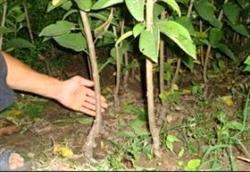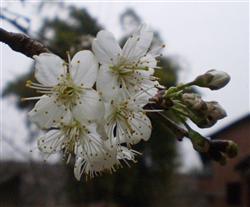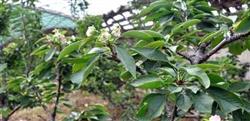Management and protection techniques of cherry after grafting

1. Untie in time. Cherry grafted in case of rain or watering, easy to cause glue flow, affecting survival. Therefore, do not water within half a month after grafting. After the budding seedlings survive, they should be untied in time to prevent Rain Water from seeping into the cortex along the binding. two。 Cut anvil at the right time. It is necessary to cut the rootstock for the buds that have survived. The suitable time for shearing rootstock is before budding turns green but before germination. Cutting rootstock prematurely can cause rootstock to drain dry and cause budding death. Shearing stock is to use pruning shears to cut off the rootstock seedlings about 1 cm on the buds. When cutting the rootstocks, the side of the buds is slightly higher and the dorsal side of the buds is slightly lower, forming a slope, which is conducive to healing. 3. Tie the ends and prevent them from breaking. After the grafting bud germinates, it grows rapidly, and because the wood is soft, it is easy to bend or wind-break. Therefore, when the bud grows to 20-30cm, it is necessary to set up a pillar in time and fix the new tip on the pillar to prevent it from being broken by the wind. 4. Wipe the buds and pick the heart. During this period, the sprouts from the rootstock seedlings should be erased repeatedly, and the field management should be strengthened to promote the growth of grafted seedlings. When the grafted seedling grows to 30cm to 40cm, the seedling is coring to promote the lower part of the branch. In the first and middle of July, the upper branches can be picked again, which can increase the number of branches and is beneficial to the early fruiting of seedlings. 5. Fertilizer and water management. After the grafted seedlings sprout, the management of fertilizer and water should be strengthened and water should be watered every 20 days or so. Combined with watering and timely topdressing of chemical fertilizer, the first time can be in mid-late May, topdressing urea 5-10 kg per mu. The second time can be in mid-July, topdressing about 15 kg of diammonium phosphate per mu. In the future, fertilizer and water should be properly controlled to ensure the maturity of seedlings and improve their overwintering ability. 6. Control diseases and insect pests. After sprouting in spring, attention should be paid to the control of the small gray weevil, and after the coring seedlings germinate new shoots, the harm of pear heart borer should be prevented. From early July to early August, 250 times multi-dose Bordeaux liquid was sprayed twice to prevent early defoliation.
- Prev

How to manage cherries before they blossom and mature?
The flower and fruit management of cherry is mainly reflected in pollination and fruit protection, fruit thinning and fruit protection before harvest. Cherry is a fruit tree with low self-flowering and fruiting ability. in order to ensure fruit, in addition to configuring pollination trees during the establishment of the garden, artificial pollination and auxiliary pollination by flower-visiting insects should be done to improve the fruit setting rate. At the same time,
- Next

Skillful management after cherry blossom
Big cherry spring blossom and summer fruit. Recently, many cherry growers called to inquire about cherry post-blossom management technology. in this regard, the reporter visited Zhang Zhicheng, an expert on miscellaneous fruits at Northwest University of Agriculture and Forestry Science and Technology. Zhang Zhicheng reminded farmers that big cherries mature more than 30 days after blossom and are now in the critical period of technical management from post-flowering to fruit ripening.
Related
- Moge, come on! The staff of the peasant association in the producing area of cantaloupe were frightened when the crowd gathered.
- Causes and Solutions of low Fruit setting rate of Apple
- Symptoms and control measures of passion fruit virus disease
- Fruit growing lesson: how do apple orchards keep high yields?
- Can you build orchards in the mountains? What are the pros and cons?
- How to manage the coloring period of Crisson grape?
- This paper introduces the processing technology of two kinds of fig products.
- How much is a month for retired teachers in rural areas by 2020?
- How can strawberry planting increase sugar content? We should pay attention to management in many aspects.
- What are the cultivation techniques on how to improve the yield of golden fruit?

